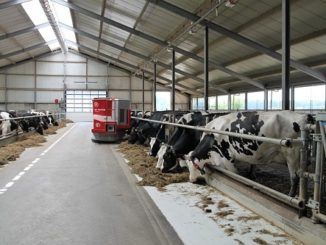Introduction
Mastitis is one of the most important economical diseases of dairy cattle. Generally, the clinical form of mastitis divided into mild, moderate or severe. In mild cases, visible abnormality is limited to the milk only i.e. clots, flakes or watery milk. The animal may have a fever, off-feed, depressed, and down. Severe clinical mastitis is often called acute mastitis. Generally, the mastitis is produced by a variety of gram positive and negative bacterial species and is characterized by inflammation of parenchyma of the mammary gland with physical, chemical and bacteriological changes in the milk and pathological changes in the grandular tissues (Radostits et al., 2007). It is also defined as inflammation of mammary gland or udder tissue parenchyma which is caused by bacteria and its toxins (Sharma et al., 2006).
Case History
A milk sample of cow was presented to Disease Investigation Laboratory, Rudrapur, Department of Animal Husbandry, Uttarakhand with the history of decreased appetite, depression, decreased milk yield and with swollen mammary gland for a few days. Animal was previously been treated with third generation antibiotics but it did not show any response. Milk was stripped for testing and found flakes and the colour of the milk is yellowish brown. Treatment with both topical and parenteral administration of anti-inflammatory, antibiotics and other supportive drugs was given for seven days continuously and cow recovered completely with alleviation of clinical signs and normal milk secretion.
Laboratory Findings
Further milk sample was tested for white side test, cultural and antibiotic sensitivity test and was diagnosed as clinical mastitis developed due to Staphylococcus aureus (Fig. a). By clinical signs, consistency and pH of milk (8.0) (Fig. b) and cultural examination the case was diagnosed as clinical mastitis. Gram staining revealed presence of gram positive cocci in cluster. Antibiotic sensitivity test showed a little sensitivity to Gentamicin and to rest it was resistant (Fig. c).

Sensitivity Report
Ciprofloxacin- Resistant
Oxytetracycline- Resistant
Amoxycillin- Resistant
Penicillin- Resistant
Gentamicin- Intermediate
Ceftriaxone- Resistant
Treatment
Accordingly, treatment was started with Inj. Gentamicin for 7 daysgiven I/M and other medication with Inj. Flunixinemeglumine15 ml I/M, Inj. Anistamine15 ml I/M, Inj.Toxol- 20 ml I/M given for 5 days. One dose of Inj. Intavita(Vitamin A, D3 and E) 5 ml given deep I/M once. Cow started showing response from third day onwards and recovered completely after seven days of treatment with improvement in health condition and milk yield without flakes, normal colour and pH.
Conclusion
With the present findings it can be concluded that change in milk colour and pH can be considered as cow side tests for diagnosis of mastitis, however, cultural examination reveal the actual and confirmatory diagnosis. And antibiotic sensitivity test is an important diagnostic tool for the treatment of mastitis in bovines.
References
- Radostits OM, Gay CC, Hinchcliff K W and Constable PD. (2007). Mastitis in: Veterinary Medicine: Textbook of diseases of cattle, sheep, pigs, goats and horses 10th edition. Balliere Tindall, London. pp. 674-762.
- Sharma N., Gautam A, Upadhyay SR, Hussain K, Soodan JS and Gupta SK. 2006. Role of antioxidants in udder health: a review. Indian J. Field Vet. 2(1):73-76.
| The content of the articles is accurate and true to the best of the author’s knowledge. It is not meant to substitute for diagnosis, prognosis, treatment, prescription, or formal and individualized advice from a veterinary medical professional. Animals exhibiting signs and symptoms of distress should be seen by a veterinarian immediately. |








Be the first to comment